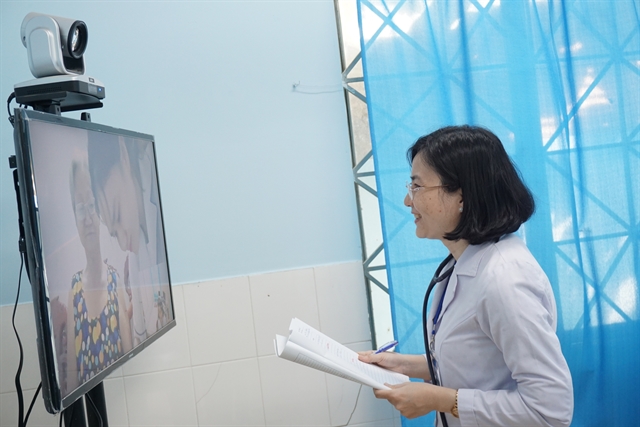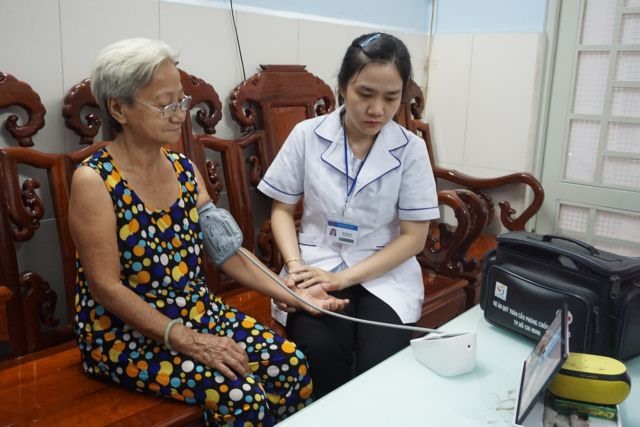 Society
Society

For many years, Ngô Thành Toại, 66, who has Type 2 diabetes, high blood pressure and dyslipidemia, regularly visited doctors once a month at Gò Vấp District Hospital in HCM City.

|
| Nguyễn Thị Thương, head of the Health Station in Gò Vấp District's Ward 16, conducts a remote medical examination for a senior patient via telemedicine. — VNS Photos Thu Hằng |
by Thu Hằng
HCM CITY — For many years, Ngô Thành Toại, 66, who has Type 2 diabetes, high blood pressure and dyslipidemia, regularly visited doctors once a month at Gò Vấp District Hospital in HCM City.
Today, a nurse at the Health Station in Gò Vấp District’s Ward 16 visits his house each month to check his blood pressure and health conditions before being connected to a doctor at the station via live telemedicine. Based on the conversation and the nurse’s report, the doctor will offer advice and prescribe medicine.
His sister, Ngô Thị Ngọc Mai, 70, who lives with the family, has also chosen remote medical care to monitor her high blood pressure and joint pains.
Toại's wife, Hầu Thị Yến, said she had previously taken her husband and sister-in-law to the hospital by taxi for their periodic health examinations. "Now it is so convenient and cost-saving for us to have remote health care services as it is a bit difficult for the three of us to travel to the hospital for regular examinations. I only go to the health station to pick up medicine prescriptions each month."
Toại and his family can also call the health station at any time if they need to see a nurse at his home.

|
A nurse at Ward 16 Health Station in HCM City's Gò Vấp District visits a senior patient and connect her to a doctor at a health station via telemedicine.
Innovative care
Dr. Nguyễn Trung Hòa, director of Gò Vấp District’s Health Centre, said the centre began using telemedical health care technology for telemedicine consultations in October.
“Remote medical care services for senior patients with chronic medical conditions have been a pressing need during the Covid-19 pandemic,” Hòa said.
In March the centre kicked off remote medical care via live communication between doctors and patients to meet the demand of senior patients, he said.
The innovative model used at three health stations in Gò Vấp District and the Nguyễn Thái Sơn Clinic has received positive feedback from senior patients.
Nurses visit patients’ houses for health check-ups and connect to doctors via telemedicine for further examination and treatment as well as for drug prescriptions, without the need for a face-to-face visit, he said.
Over the last three months, nearly 800 patients have received remote medical care services that have helped reduce costs and time.
Nguyễn Thị Thương, head of the Ward 16 Health Station, said the health monitoring of seniors has been closely managed with remote medical care via telemedicine.
“Most senior patients with chronic non-communicable diseases such as high blood pressure, diabetes and musculoskeletal diseases want to receive healthcare services at home,” Thương said.
With only one or two doctors working at the health station, it is impossible to closely monitor a large number of patients, she said.
Nearly 3,000 people aged 60 and above live in the district’s Ward 16, and only 20 per cent of them have their medical conditions monitored at the ward’s health station.
Tăng Chí Thượng, deputy director of the city’s Department of Health, said that the remote medical care model met the demand of senior patients for services at home. It has also helped to ensure the continuity of care, which is a cornerstone of primary care for public health and reduced overcrowded at hospitals.
Because of the initial positive results, the department will develop a standard procedure and model for remote health care and scale it up in other city districts, he said. — VNS
Download the 'Việt Nam News' app to read our newspapers everyday